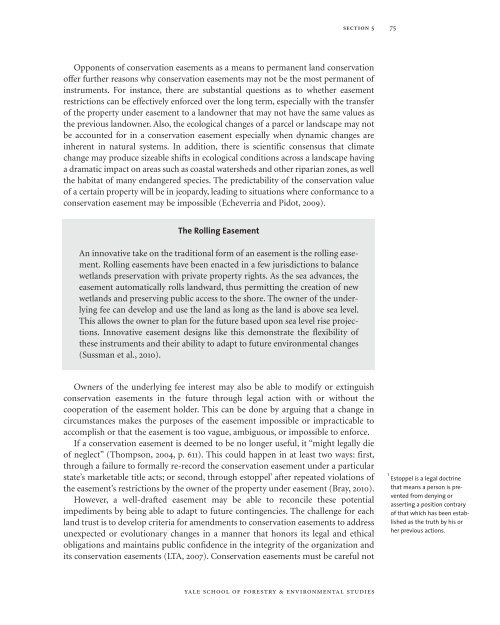Complete Report - Yale University
Complete Report - Yale University
Complete Report - Yale University
You also want an ePaper? Increase the reach of your titles
YUMPU automatically turns print PDFs into web optimized ePapers that Google loves.
SECTION 575Opponents of conservation easements as a means to permanent land conservationoffer further reasons why conservation easements may not be the most permanent ofinstruments. For instance, there are substantial questions as to whether easementrestrictions can be effectively enforced over the long term, especially with the transferof the property under easement to a landowner that may not have the same values asthe previous landowner. Also, the ecological changes of a parcel or landscape may notbe accounted for in a conservation easement especially when dynamic changes areinherent in natural systems. In addition, there is scientific consensus that climatechange may produce sizeable shifts in ecological conditions across a landscape havinga dramatic impact on areas such as coastal watersheds and other riparian zones, as wellthe habitat of many endangered species. The predictability of the conservation valueof a certain property will be in jeopardy, leading to situations where conformance to aconservation easement may be impossible (Echeverria and Pidot, 2009).The Rolling EasementAn innovative take on the traditional form of an easement is the rolling easement.Rolling easements have been enacted in a few jurisdictions to balancewetlands preservation with private property rights. As the sea advances, theeasement automatically rolls landward, thus permitting the creation of newwetlands and preserving public access to the shore. The owner of the underlyingfee can develop and use the land as long as the land is above sea level.This allows the owner to plan for the future based upon sea level rise projections.Innovative easement designs like this demonstrate the flexibility ofthese instruments and their ability to adapt to future environmental changes(Sussman et al., 2010).Owners of the underlying fee interest may also be able to modify or extinguishconservation easements in the future through legal action with or without thecooperation of the easement holder. This can be done by arguing that a change incircumstances makes the purposes of the easement impossible or impracticable toaccomplish or that the easement is too vague, ambiguous, or impossible to enforce.If a conservation easement is deemed to be no longer useful, it “might legally dieof neglect” (Thompson, 2004, p. 611). This could happen in at least two ways: first,through a failure to formally re-record the conservation easement under a particularstate’s marketable title acts; or second, through estoppel 1 after repeated violations ofthe easement’s restrictions by the owner of the property under easement (Bray, 2010).However, a well-drafted easement may be able to reconcile these potentialimpediments by being able to adapt to future contingencies. The challenge for eachland trust is to develop criteria for amendments to conservation easements to addressunexpected or evolutionary changes in a manner that honors its legal and ethicalobligations and maintains public confidence in the integrity of the organization andits conservation easements (LTA, 2007). Conservation easements must be careful not1 Estoppel is a legal doctrinethat means a person is preventedfrom denying orasserting a position contraryof that which has been establishedas the truth by his orher previous actions.yale school of forestry & environmental studies
















